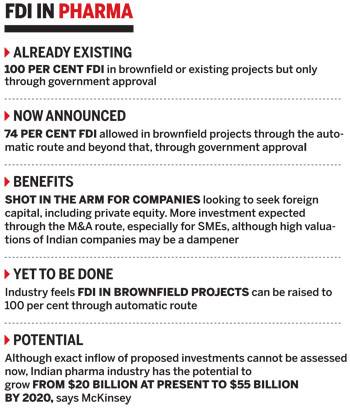Foreign Direct Investment (FDI): India
(→2004-16: FDI inflows in India) |
|||
| Line 109: | Line 109: | ||
'''June''': 100 per cent FDI in trading including through e-commerce, amendments to FDI in defence sector policy, 100 per cent FDI in teleports, DTH, mobile TV, 100 per cent FDI in brownfield aviation projects, 74 per cent FDI in private security agencies, amendments to FDI in animal husbandry policy, relaxing norms in single brand retail. | '''June''': 100 per cent FDI in trading including through e-commerce, amendments to FDI in defence sector policy, 100 per cent FDI in teleports, DTH, mobile TV, 100 per cent FDI in brownfield aviation projects, 74 per cent FDI in private security agencies, amendments to FDI in animal husbandry policy, relaxing norms in single brand retail. | ||
| − | ==2004-16: FDI inflows | + | ==2004-16: FDI inflows into India== |
[http://epaperbeta.timesofindia.com/Article.aspx?eid=31808&articlexml=Modis-Make-in-India-a-success-Moodys-08042016026031 ''The Times of India''], April 8, 2016 | [http://epaperbeta.timesofindia.com/Article.aspx?eid=31808&articlexml=Modis-Make-in-India-a-success-Moodys-08042016026031 ''The Times of India''], April 8, 2016 | ||
| Line 125: | Line 125: | ||
On FDI, Moody's said that the development of industrial corridors, investment & manufacturing zones, and `smart cities' will further bolster investment inflows. “In particular, flows into the manufacturing sector are likely to accelerate as the government seeks to boost the sector's share of gross domestic product (GDP) to 25% by 2022.Government investment in infrastructure will help address some of India's deficiencies in this area and foster FDI,“ the report added. | On FDI, Moody's said that the development of industrial corridors, investment & manufacturing zones, and `smart cities' will further bolster investment inflows. “In particular, flows into the manufacturing sector are likely to accelerate as the government seeks to boost the sector's share of gross domestic product (GDP) to 25% by 2022.Government investment in infrastructure will help address some of India's deficiencies in this area and foster FDI,“ the report added. | ||
| + | |||
==2011-16== | ==2011-16== | ||
Revision as of 20:26, 3 May 2018
This is a collection of articles archived for the excellence of their content. |
Contents |
FDI in India: A timeline
1991-2016
The Hindu, June 21, 2016
Twenty-five years of changes in FDI policy: highlights
1991
July: New industrial policy of Narasimha Rao government as part of the Union Budget presented by Manmohan Singh, which led to a substantive opening up of the Indian economy.
August: FDI up to 51 per cent opened up in 47 high-priority sectors, including software (with 34 sectors under automatic route), with a condition that capital goods imports be financed by foreign equity. Export trading firms, hotels and tourism businesses also allowed 51 per cent FDI.
Foreign Investment Promotion Board (FIPB) set up in the PMO to vet FDI proposals, with a Finance Minister-headed panel deciding on investments taking a call on FDI over Rs 300 crore.
1992
April: FDI in software also put on automatic route.
May: Use of foreign brand names allowed.
June: Dividend balancing norms for FDI-backed firms, linking dividend payments to export income, scrapped for all but consumer goods firms.
1994
October: FDI in Pharma up to 51 per cent put on automatic approval route, except for recombinant DNA technologies.
1996
FIPB transferred to Department of Industrial Policy and Promotion (DIPP); approvals up to Rs. 600 crore by Industry Minister, Cabinet Committee for nods over Rs. 600 crore.
November: Condition linking import of capital goods to foreign equity investments scrapped.
1998
October: 49 per cent FDI allowed in mobile telephony by satellite.
1999
January: FDI in construction of highways, toll roads and ports raised from 74 per cent to 100 per cent.
March: Timeline for considering FDI proposals slashed from six weeks to 30 days.
2000
March: Eases norms for 100 per cent FDI in NBFCs.
October: 26 per cent FDI in insurance sector.
2001
May: 100 per cent FDI in drug manufacturing and pharma, airports, hotel, tourisms, 26 per cent FDI in defence, 74 per cent in select activities of telecom sector, 49 per cent FDI in banking sector.
2004
January: 100 per cent FDI in petroleum product marketing, oil exploration, petroleum production and natural gas pipelines.
March: 74 per cent FDI in private banks.
2005
March: 100 per cent FDI in townships.
November: 74 per cent FDIin telecom, 20 per cent FDI in radio broadcasting.
2006
February: 51 per cent FDI in single brand retail.
March: 74 per cent FDI in telecom.
2008
March: 100 per cent FDIin airports, 74 per cent FDI in non-scheduled air transport services.
2009
January: 100 per cent FDI in fax publication of foreign newspapers, 26 per cent FDI in publication of Indian versions of foreign publications.
2011
November: 100 per cent FDI in brownfield pharmaceutical projects (earlier only in greenfield).
2012
January: 100 per cent FDI in single brand retail.
September: 52 per cent FDI in multi-brand retail. 49 per cent FDI in aviation companies, power exchanges. 74 per cent FDI in teleports, mobile TV.
2014
August: 49 per cent FDI in defence sector, 100 per cent FDI in some aspects of rail infrastructure.
2015
March, April: 49 per cent FDI in insurance, pension sectors.
2016
June: 100 per cent FDI in trading including through e-commerce, amendments to FDI in defence sector policy, 100 per cent FDI in teleports, DTH, mobile TV, 100 per cent FDI in brownfield aviation projects, 74 per cent FDI in private security agencies, amendments to FDI in animal husbandry policy, relaxing norms in single brand retail.
2004-16: FDI inflows into India
The Times of India, April 8, 2016
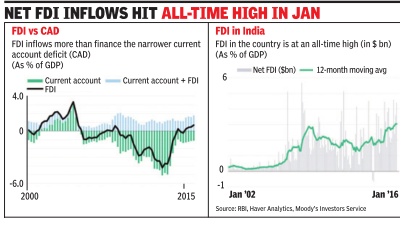
FDI Financing CAD First Time Since 2004
Ratings agency Moody's has said that net foreign direct investment (FDI) inflows have hit an all-time high in early 2016, highlighting the success of Narendra Modi's `Make in India' initiative. The ratings agency said that the FDI in flows have more than financed the current account deficit (CAD) for the first time since 2004. A country is known to be facing a CAD when the value of its imports is more than the value of its exports.
“The rise in FDI points to stronger investor interest in India on the back of ro bust economic growth. Higher inflows also suggest that recent government policies, such as efforts to liberalize foreign investment limits in several sectors and the `Make in India' initiative, are bearing fruit,“ said Moody's in a report released on Thursday .
Net FDI inflows into India hit an all-time high in January 2016 at $3 billion on a 12-month moving average basis. India's current account deficit is now more than covered by its FDI inflows. The basic balance (the sum of the current account balance and net FDI) returned to surplus in 2015 after being in deficit from 2003-2014.
This is good news for the do mestic currency whose value has been determined by capital flows due to the country's per manent trade deficit. The only dark cloud has been the drop in remittances. Money sent by overseas Indians dropped 30% year-on-year in the SeptemberDecember 2015 quarter due to turmoil in the Middle East economy . But Moody's said that In dia's external financing needs have diminished sharply over the last three years due to a crash in commodity prices.
On FDI, Moody's said that the development of industrial corridors, investment & manufacturing zones, and `smart cities' will further bolster investment inflows. “In particular, flows into the manufacturing sector are likely to accelerate as the government seeks to boost the sector's share of gross domestic product (GDP) to 25% by 2022.Government investment in infrastructure will help address some of India's deficiencies in this area and foster FDI,“ the report added.
2011-16
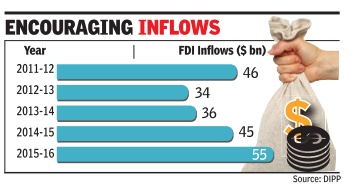
See graphic, 'FDI inflows in India, year-wise, 2011-16'
2016
India: World's top greenfield FDI destination
India retains world's highest FDI recipient crown: Report, May 25, 2017: The Times of India
HIGHLIGHTS
India attracted USD 62.3 billion in 2016, says the FDI Report 2017
India has remained ahead of China and the US as far as FDI inflows were concerned in the last year, it states.
FDI by capital investment saw an increase of 2 per cent to USD 62.3 billion in 809 projects during 2016 in India
India retained its numero uno position of being the world's top most greenfield FDI investment destination for the second consecutive year, attracting US $62.3 billion in 2016, says a report.
India has remained ahead of China and the US as far as FDI inflows were concerned in the last year, said the fDi Report 2017 compiled by fDi Intelligence, a division of The Financial Times Ltd.
FDI by capital investment saw an increase of 2 per cent to US $62.3 billion in 809 projects during 2016 in India.
"India managed to keep the crown as the world's number one location for greenfield capital investment for the second year running - ahead of China and the US," the report said. The report said, global investment landscape has changed considerably in 2016 as FDI gravitated to locations experiencing the strongest economic growth, while locations in recession or facing high levels of uncertainty saw major declines.
In 2016, greenfield FDI continued to rise worldwide, with capital investment increasing by more than 6 per cent to US $776.2 billion, its highest since 2011, alongside an increase in job creation by 5 per cent to 2.02 million. The number of FDI projects, however, declined 3 per cent to 12,644. China has overtaken the US to become the second biggest country for FDI by capital investment, recording US $59 billion of announced FDI, compared with US $48 billion-worth in the US.
Globally, the real estate sector has claimed the top spot for capital investment, with US $157.5 billion of announced FDI recorded in 2016, following an increase of 58 per cent. In value terms, coal and natural gas witnessed an inflow of US $121 billion, followed by alternate and renewable energy at US $77 billion.
Defence
Shweta Punj Sandeep Unnithan MG Arun , The FDI big bang “India Today” 23 6 2016
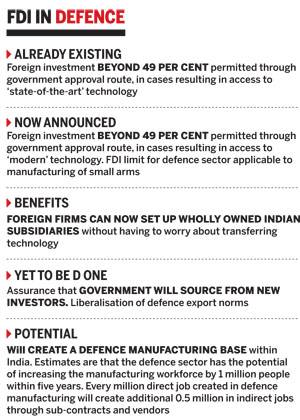
Pharma
Shweta Punj Sandeep Unnithan MG Arun , The FDI big bang , 23/6/2016
India at Global level
See graphic
Shweta Punj Sandeep Unnithan MG Arun , The FDI big bang “India Today” 4/7/2016
Retail
See graphic
Shweta Punj Sandeep Unnithan MG Arun , The FDI big bang “India Today” 4/7/2016
Foreign companies registered in India
Feb 09 2015
DESTINATION INDIA
As of December, 2014, there were over 4,000 foreign companies registered in the country. Of these, a little over 79% were active.Interestingly. the national capital had the highest number of such companies. It was followed by Maharashtra, Karnataka, Haryana and Tamil Nadu, usually perceived as some of the most industrialized states. The relatively large number of companies registered in Haryana seems to be linked to MNCs located in Gurgaon, one of the NCR's leading business hubs
Amount invested
FDI by G20 nations: 2000-15
The Times of India ,Sep 02 2015
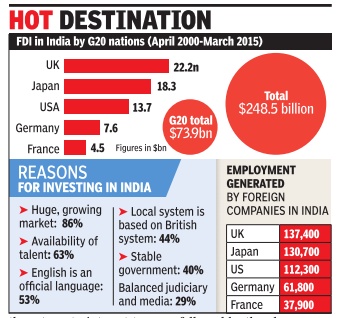
Kounteya Sinha
UK leads G20 nations flow to India in FDIHOT The latest data to confirm Britain's increasing interest in investing in India will make PM Narendra Modi happy a couple of months before he embarks on his maiden visit to the United Kingdom. The UK has become the largest investor in India among all G20 countries with a combined revenue of more than $54 billion in India.
Between the year 2000 and 2015, UK's FDI into India amounts to $22 billion -9% of all FDI in the country .
In total, G20 nations invested $ 73.9 billion in India between 2000-2015 with the UK being the single largest G20 investor into India followed by Japan ($ 18.3 bn), the US ($13.7bn), Germany ($ 7.6 bn) and France ($ 4.5 billion).
As India's largest employer, UK firms employ around 691,000 people across the country -5.5% of total organized private sector jobs in the country . Between 2000 and 2015, UK FDI generated around 138,000 direct jobs, 7% of the total 1.96 million jobs generated by FDI in India.
India's massive talent pool was the main reason for 63% of the British companies to believe in India's potential while India's recent growth story made 86% of them turn to interest towards the Asian giant. English being an official language has helped, too, with 53% of the companies relying on it while 40% said it was the country's stable government.
Confederation for British Industry's first Sterling Assets India report sponsored by PwC UK and brought out in association with the UK India Business Council says that Maharashtra and Delhi have attracted the bulk of Britain's FDI into India -26% and 20% respectively .
The chemicals sector attracts the lion's share of British investment in India, at $5.78 billion (26% of UK FDI), followed by the pharmaceutical sector at $3.76 billion (17% of UK FDI) and the food processing sector at $3.05 billion (14% of UK FDI).
Katja Hall, the confederation's deputy DG, said, “The economic relationship between India and the UK is in fine fettle. The UK has played a significant role in India's growth journey , investing more and creating more jobs than any other G20 nation.PM Modi's steps to improve the ease of doing business in India are a great boost and we look forward to the EU-India FTA talks resuming.“
60% increase, Oct 2014-Sept 2016
FDI jumps 60% in Oct 2014-Sept 2016, Nov 22 2016 : The Times of India
FDI went up 60% to $77.9 billion after the launch of `Make in India' initiative in September 2014, the government said on Monday.
Commerce and industry minister Nirmala Sitharaman said that after the launch of this initiative, there has been an “unprecedented“ increase in FDI into the country.
“During the period October 2014 to September 2016, total FDI equity inflows of $77.9 billion was recorded as against $48.5 billion received during the preceding 24 months with an increase of 60%,“ she said in a written reply to the Lok Sabha.
Make in India was launched with an aim to promote India as an important investment destination and a global hub for manufacturing. Replying to a separate question, she said a total of 19,666 comp laints were received by the National Consumer Helpline during April-October this year. In 2015-16, this number was 23,955.
“24 e-commerce companies were incorporated registered in India during the last two years (2014-15 and 2015-16),“ she added.
Private Equity (PE) investments: 2014, 2015
The Times of India, Oct 22 2015
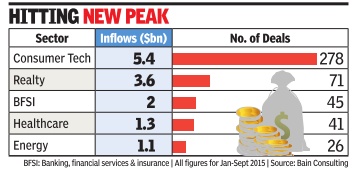
Reeba Zachariah
PE inflows may hit record $20bn in 2015
If the last nine months of private equity (PE) activity are any indication, PE investments are poised for a strong finish in 2015. Bain Consulting, the leader in consulting to PE firms in India and globally , predicts that PE transactions will touch a record $20 billion this year, higher than the previous record of $17.1 billion in 2007.Heightened financing in consumer technology space and bigticket investments in real estate and financial services will propel PE activity to hit a new high this calendar. PE investments for the first nine months of 2015 have al ready hit $16.7 billion, outpacing 2014's total PE deal value of $15.2 billion. “The growth trend indicates that PE investment activity this year will surpass 2007, which was the best period so far,“ said Madhur Singhal, consulting principal, private equity practice, Bain Consulting.
The deal activity has been chiefly driven by the country's booming consumer technology sector, which attracted $5.4 billion of investments, followed by real estate and financial services with $3.6 billion and $2 billion, respectively , during the first nine months of 2015.
Bain Consulting's PE deals database doesn't include transactions where deal value is not disclosed. The three sectors accounted for 65% of the total deal value in the January-September period of 2015 and are expected to keep up the momentum in the October to December period too. “The consumer tech space needs more capital to scale up and will continue to attract more private equity ,“ Singhal said. Early-stage and growth investments dominated 85% of the deals in the first nine months of 2015.
PE funds such as Tiger Global, Blackstone, Temasek, Advent, SoftBank, Actis and GIC have invested about $125 billion in 5,400 deals between 2005 and September-end of 2015. However, exits from portfolio companies continue to remain challenging.Many funds have been forced to hold on to their investments for a longer number of years than originally envisaged.
Exits reached $4.5 billion in the first nine months of this year, driven by public market and secondary sales. Real estate, financial services and telecom witnessed the highest number of exits. The top 10 big-ticket exits, including TPG Capital selling its stake in Shriram City Union Finance for $386 million and New Silk Route offloading its interest in PNB Housing Finance for $257 million, constituted 40% of the total PE exit value in the first nine months of 2015.
Confusion over Financial Times figures
The Times of India, Oct 01 2015
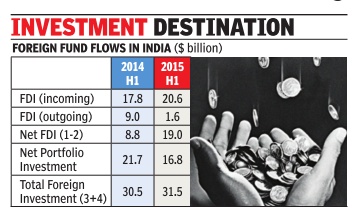
Subodh Varma
RBI pegs fund flow at $20.6Bn in first half of 2015 against FT estimate of $31Bn
A recent report by a data consultancy owned by the FT of London created a stir by estimating that India is now the most favourite destination for foreign direct investment, beating China and the USA. The fine print indicates that they are talking about “estimated capital expenditures“ in greenfield, that is, new ventures. By this estimate, India attracted $31 billion compared to China's $28 billion in the first half of 2015. Reserve Bank of India (RBI) data for foreign investment flows does not appear to reflect this, causing much puzzlement in India. The total foreign direct investment that flowed into India between January and June 2015 is pegged at $20.6 billion. If you deduct the outflow from India in the form of outgoing FDI from India, this gets pared down to $19 billion.
Besides this inflow, there is also foreign portfolio investment mainly by institutional investors in the stock market. This was about $17 billion in the first half of 2015.
When put together, these two components of investment direct and portfolio yields about $31.5 billion for the same period. But this could hardly be what the FT report is talking about since much of this is neither greenfield nor capital investment.
The other puzzling aspect of the FT report is the com parison with China.
According to the National Statistical Bureau of China, foreign direct investment into China in the first half of 2015 was a whopping $68.4 billion, more than three times that of India's $20.6 billion, between January and June 2015.
A comparison of RBI data between the first halves of 2014 and 2015 shows that incoming FDI has increased by about 16% in 2015 but outgoing FDI has drastically declined, probably due to weakening economies around the world. Hence net FDI inflow to India has jumped up from $8.8 billion to $19 billion.
Analysis of this data by India's Department of Industrial Policy and Promotion (DIPP) indicates that most of the foreign direct investment has come into the IT sector followed by automobiles, trade and the financial sector. Major sources of FDI in India remain Singapore and Mauritius followed by the Netherlands, US and Germany .
Net portfolio investment has, however, sharply declined by about 23% from $21.7 billion in the first half of 2014 to $16.8 billion in the comparable period of 2015.
As a result of these opposing trends, the net foreign flows into India have shown only a marginal increase from $30.5 billion to $31.5 billion between the first halves of 2014 and 2015.
2014: India's rank in the world

See graphic: 'India and the world, The 15 countries that received the highest FDI in 2014. India was no 9'
2015: India no. 1 destination

The Times of India, Sep 30 2015

India pips US, China as No. 1 FDI destination
Rises 16 llaces in ranking of competitiveness
India has emerged on top of the foreign direct investment (FDI) league table, overtaking China and the US, according to fDi Markets, the FT data service. A ranking of the top destinations for greenfield investment (measured by estimated capital expenditure) in the first half of 2015 shows India at number one, having attracted roughly $3 billion more than China and $4 billion more than the US.
India has also moved up on the World Economic Forum's Global Competitiveness Index by 16 places to 55th position from 71st.
The two reports come as a shot in the arm for the Modi government, which has taken several steps to attract foreign investment and has helped revive the mood of investors since it came to office in May 2014.
“Satisying, our efforts are paying off,“ finance minister Arun Jaitley tweeted.
The government has unveiled several initiatives like `Make in India' and `Digital India' to lure investors.
It has moved to ensure that the country moves up on the World Bank's Ease of Doing Business and states have also started their clean-up act on this parameter.
But experts say there are several areas where the government needs to step up reforms. The areas where investors want more reforms include tax policy, labour laws, cutting red tape and issues linked to land acquisition.
Investors have started taking interest in India and the recent visit of PM Modi to Silicon Valley triggered enormous interest from software and technology czars. India's growth is expected to be the fastest among large economies. Several multilateral agencies have also pointed out that India is a beacon of hope at a time when emerging economies are taking a hit and the Chinese stock market is witnessing volatility. Experts say India is expected to benefit from the slowdown in China and the overall sluggishness in global commodity prices including crude oil is expected to provide a cushion to the growth fortunes of Asia's third largest economy . The government is confident of achieving close to 8% growth in the current fiscal year. India has also moved up on Global Competitiveness Index by 16 places to 55th position.
The FT said that for the past several years, China and the US have vied for FDI supremacy and fought each other nearly to a draw last year, with the US ranking as the number one greenfield destination by number of projects and China coming in first by capital expenditure.
It said India ranked fifth last year for capital investment, after China, the US, the UK and Mexico. In a year when many other major FDI destinations posted declines, India experienced one of 2014's best FDI growth rates, increasing its number of projects by 47%, the article said.
“India is tracking well ahead of where it was at this time last year: it has more than doubled its midyear investment levels, attracting $30 billion by the end of June 2015 compared with $12 billion in the first half of last year,“ the newspaper said.
“Research from fDi Markets found 97 of 154 countries typically classed as emerging markets experiencing declines in capital expenditure on greenfield investment projects in the first six months of this year compared with the same time period last year,“ it said.
2016: India was among Top 15, but got 2% of global FDI
See graphic:
Biggest FDI destinations, 2016; Annual growth rate among top FDI recipients, 2006-16

From: November 23, 2017: The Times of India
2018: India, 5th most attractive investment destination
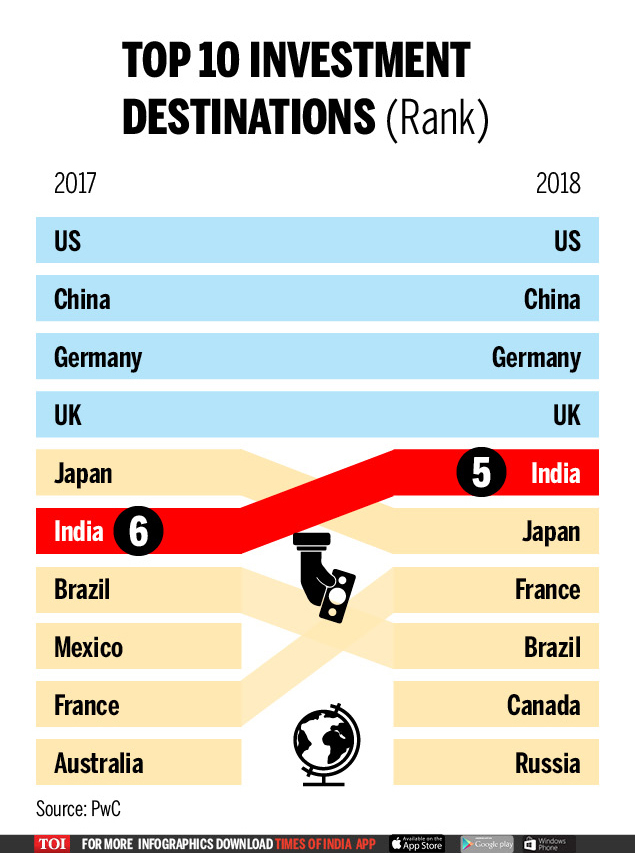
From: Sidhartha, Global CEOs see India as 5th most attractive investment destination, January 22, 2018: The Times of India
See graphic:
Top 10 investment destinations (2018)
India moved up a notch to overtake Japan as the fifth most attractive investment destination in a survey of global CEOs, even as the International Monetary Fund said that the country will once again emerge as fastest growing major economy in 2018 amid signs of an improvement in the overall economic environment.
In a survey conducted by consulting firm PricewaterhouseCoopers, chief executives said that excluding their home market they are most likely to invest in the US, followed by China with the world's largest economy expanding its gap as corporate chiefs expect more rapid growth in America. While China held on to its popularity, India moved a up slightly but still trailed Germany and the UK as an investment destination.
The survey will come as a booster for Prime Minister Narendra Modi who will court international investors+ on Monday and Tuesday in a bid to get more investment into the country, especially in the manufacturing sector, which has remained sluggish and is crucial to job creation.
"Backed by definitive structural reforms, the India story has been looking better in the past one year. Most of our clients are optimistic about their growth. The government has made efforts to address concerns around areas like infrastructure, manufacturing and skilling, although newer threats like cybersecurity and climate change are beginning to play on the minds of our clients," said Shyamal Mukherjee, chairman, PwC India.
Aided by opening up of several key sectors over the last few years, foreign direct investment in India surged 17% to over $25 billion during the first half of the current financial year, even as private investment has remained muted due to excess capacity and high financial stress. It had for the first time topped $60 billion in 2016-17 but remains less than half of China's $137 billion in 2017, which was an increase of around 8%.
But IMF on Monday reiterated its earlier estimate that India will grow 7.4% in 2018 and accelerate to 7.8% in 2019 from 6.7% last year. In contrast, China, which IMF estimates suggested grew 6.8%, a ad faster than India, is estimated to slow down to 6.6% in 2018 and further to 6.4% next year.
At a press conference, IMF chief Christine Lagarde urged global policymakers to "fix the roof" while the going was good, calling for a more inclusive development strategy as nearly one-fifth of developing and emerging economies saw their per capita income decline in 2017.
She also asked for structural or fiscal reforms and called upon leaders to put together a robust global collaboration to fight corruption, improve conditions for trade, stop tax evasion and prevent catastrophic climate change.
Rules, changes in
November 2015: Rules changed for 15 sectors
The Times of India, November 11, 2015

Govt tries to move beyond Bihar, goes for FDI reforms
The government announced a raft of changes in the foreign direct investment (FDI) rules for 15 sectors -including retail, defence, construction, banking and electronic media. The PM also was keen to ensure that the rules provide a boost to those manufacturing locally , with sources pointing to the decision to allow “Indian manufacturers“ to retail their goods, including on e-commerce plat forms -a move that will benefit the likes of Fabindia and Hidesign. Other “manufacturers“ too have been allowed to enter the retail arena without the government's approval. In a move that will make it easier for private banks to raise capital, the government has permitted full fungibility of foreign investment in private banks. This means that there will be no sub-limits for foreign portfolio investors (FPIs). While foreign direct investment of up to 74% was permitted until now, portfolio investment -investments by foreign institutional investors -was capped at 49%. Also, banks had to approach the foreign investment promotion board (FIPB) for any increase in foreign investment above 49%. The introduction of fungibility does not, however, mean that strategic investors get a free hand in picking up chunky stakes in banks. RBI regulations require that individual investor holding is capped at below 5%. Also, even promoters of banks are required to dilute their stake below 20% over a period of time. The relaxation of cap on sub-limits is in keeping with the government's proposal to announce composite caps for FDI in various sectors announced in July 2015. However, at the time of the announcement banks were kept out as they were considered `sensitive'.
2016: Liberalised FDI rules
The Times of India, Jun 21 2016
Foreigners can now hold 100% stake in food retail, airlines
The Modi government announced fresh liberalisation of foreign direct investment (FDI) rules by throwing open food retail, airlines and private security firms to higher overseas flows. In addition, rules were eased for those looking to invest in defence, DTH services and single-brand retail as the Modi administration sought to showcase India as the “most open“ FDI destination in the world with only a handful of sectors requiring government clearance.
“The Centre has radically liberalised the FDI regime, with the objective of providing major impetus to employment and job creation in India,“ the PMO tweeted.
The government suggested that the pitch will now change to how most sectors don't face FDI restrictions.“We will soon issue a negative list of sectors and all the others will be open to FDI,“ industrial policy and promotion (IPP) secretary Ramesh Abhishek told reporters after the changes were cleared at a high-level meeting chaired by the prime minister.
Although the finance ministry had kicked off discussions and the department of IPP had begun work on easing rules a few weeks ago, the decision came on the first working day after Raghuram Rajan's announcement to return to the US on completion of his term as RBI governor in September.
Government officials said too much should not be read into the announcements sin ce Modi had scheduled the meeting earlier. But the market saw in the decisions the government's determination to counter any slide in business and market confidence and a signal to the world that reforms would continue. In particular, they come amid fe ars of the rupee coming under renewed pressure on account of a possible withdrawal of some of the $20 billionplus foreign currency deposits that are due for redemption later this year. But the urgency could be gauged from the fact that the PM used special powers to announce the decisions and did not wait for a green light from the cabinet, which was scheduled to meet on Wednesday.Modi had used the powers for a similar liberalization initiative in November 2015.
For the government, this is at least the fourth round of major FDI changes since it took office two years ago and the second since last November when the rules for a number of sectors-aviation, construction and retail, among others--were eased. Earlier, the Modi government had raised FDI caps on insurance and defence while allowing overseas flows into railways, which had remained shut two decades after the 1991 reforms. The steps fuelled a 54% jump in FDI flows in the last financial year, to a record $55.5 billion.
This time, the focus has been on removing the stiff conditions that often came with opening up a sector and which tended to deter investors. The government has therefore eased rules for defence manufacturing companies where foreign ownership is in excess of 49%. Earlier, FDI was allowed only if foreign funds were accompanied with “state of the art“ technology. Now the rules say “modern technology“ will need to come, which is seen to be more flexible.“If the defence forces need some goods and it is produced using modern technology as opposed to state of the art, a local manufacturing facility can come up,“ said a senior government official.
Consultants acknowledged that rules had been simplified. “Defence is extremely technology-driven and OEMs (original equipment manufacturers) invest huge sums of money generating technology and intellectual property. The fact that there was no control permitted earlier was a major issue that was cited for not investing in India. That obstacle has now been removed and coupled with major simplification in the DPP (defence procurement procedure), OEMs should respond positively and proactively to these path-breaking reforms,“ said Dhiraj Mathur, a partner at global consulting firm PricewaterhouseCoopers.
Even in case of food retailing, the PM chose to ignore protests from the food processing ministry on mandating sourcing norms for retailers in a segment where 100% FDI has been permitted without riders, including in e-commerce.
The government also eased norms for setting up branch office, liaison office or project office. It also simplified rules for FDI in animal husbandry.
2016: Abolition of Foreign Investment Promotion Board (FIPB)
Pradeesh Chandran, Centre to abolish FIPB, Feb 1, 2017: The Hindu Business Line
Government has shown its clear intent towards fast-tracking inflow of Foreign Direct Investments
The Budget 2017-18 has given a clear indication of the government’s intent to further liberalise policies related to foreign direct investment. It also seeks to dismantle a two-decades-old body that was formed as a beacon of the economic liberalisation of 1993: the Foreign Investment Promotion Board (FIPB). The 1993 round of reforms under the P.V. Narasimha Rao regime, for the first time, threw the doors open to foreign investors.
One of the major announcements in Finance Minister Arun Jaitley’s Budget speech was the abolition of the FIPB.
The board has offered a single window clearance for applications of prospective foreign investors in sectors falling in the approval route. The board has handled investment proposals worth up to ₹5,000 crore.
Creation of FIPB
The FIPB was formed under the Prime Minister’s Office in the mid-1990s as part of the first round of Indian economic reforms. It was reconstituted in 1996 and transferred to the Department of Industrial Policy and Promotion. It was transferred to the Department of Economic Affairs under the Ministry of Finance in 2003, according to its website.
According to government rules, foreign investments in sectors under the automatic route do not require prior approval from the FIPB and are subject to sectoral rules.
“More than 90% of the total FDI inflows are now through the automatic route. The Foreign Investment Promotion Board has successfully implemented e-filing and online processing of FDI applications.”
“We have now reached a stage where FIPB can be phased out. We have therefore decided to abolish the FIPB in 2017-18,” Mr. Jaitley said.
“Government has shown its clear intent towards fast-tracking inflow of FDI, and the scrapping of FIPB is a notable step that would go a long way in supporting the objective of ease of doing business,” stated Glenn Saldanha, Chairman and Managing Director, Glenmark Pharmaceuticals.
Meanwhile, Mr. Jaitley also stated the government’s plan to pursue more radical liberalisation in Foreign Direct Investment norms.
Government scraps 25-year-old foreign investment advisory body: 10 key takeaways
Ramarko Sengupta, May 25, 2017: The Times of India
HIGHLIGHTS
The elimination of the decades-old panel is aimed at attracting more foreign direct investment.
1. The step follows Finance Minister Arun Jaitley's budget pledge in February to abolish the institution, which was set up soon after India embarked on its first market reforms in 1991, in a departure from decades of socialist planning
2. The FIPB currently vets FDI proposals requiring government's approval up to Rs 5,000 crore. Announcing the Cabinet's decision, Finance Minister Arun Jaitley said there are just 11 sectors left in which government's approval is needed for FDI.
3. The government has opened up most of the sectors to enable foreign companies to set up shop in the country, thus nearly eliminating the need for a dedicated panel.
4. Sectors that are under the approval route for FDI includes defence and retail trading. As per the proposed mechanism, respective ministries would take care of the FDI proposals.
5. In June 2016, the government had relaxed FDI norms in single-brand retail, civil aviation, airports, pharmaceuticals, animal husbandry and food products, which meant these sectors did not need FIPB's approval anymore.
6. FIPB was set up in the early 1990s; it was then under the Prime Minister's Office. In 1996, it was transferred to the commerce ministry's department of industrial policy and promotion, and to finance ministry's department of economic affairs in 2003. Economic Affairs Secretary Shaktikanta Das heads it currently.
7. Post the FIPB abolition, the government might ease FDI norms further in a few sectors. There could be an increase in the FDI limit in print news media to 49 per cent from the current 26 per cent and single-brand retail could be on the full automatic route.
8. Sectors where industry players have asked for further easing of rules include aviation, defence and pharmaceuticals.
9. The government had allowed full FDI in defence after approval; investors can pump in up to 49 per cent through automatic route. For brownfield projects in the pharmaceutical sector, automatic approval had been extended to 74 per cent.
10. The abolition of the FIPB is expected to facilitate easier capital inflows into India from foreign companies.
Retail, real-estate (100%); MHA security replaced
100% FDI Allowed In Single-Brand Retail Under Automatic Route, January 11, 2018: The Times of India
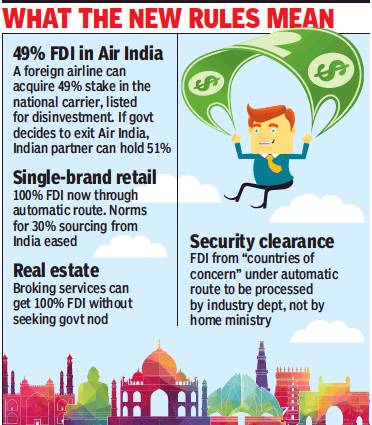
From: 100% FDI Allowed In Single-Brand Retail Under Automatic Route, January 11, 2018: The Times of India
In reforms push, foreign airlines allowed 49% in AI
The Union Cabinet unveiled a fresh round of liberalisation of the foreign direct investment (FDI) policy, allowing foreign airlines to invest up to 49% in Air India, and opening up 100% FDI in singlebrand retail under the automatic route. Similarly, 100% FDI has been allowed via the automatic route in real estate broking services.
Under the existing rules, foreign airlines can invest, with government approval, in Indian companies operating scheduled and non-scheduled air transport services, up to 49% of their paid-up capital. However, this provision was not applicable to Air India, implying that foreign airlines could not invest in the national carrier.
Foreign Cos Cannot Mandate Auditor Of Their Choice
Foreign Cos Cannot Mandate Auditor Of Their Choice
The government has quietly slipped in a swadeshi move while liberalising the foreign direct investment (FDI) rules by mandating that overseas auditors will have to undertake joint audit if an international investor insists on audit by a global firm, or its Indian affiliate.
This marks a major shift in India’s FDI regime, which was earlier silent on the issue and resulted in a situation where the shareholders’ agreement between a foreign investor and its Indian partner contained a clause specifying audit by Big Four firms such as KPMG, Ernst & Young, Deloitte or PricewaterhouseCoopers or Indian firms that are part of their network. The clause has been inserted to prevent this kind of an arrangement and the belief is that one global firm will not agree to a joint audit with an international rival and this will open the doors for standalone Indian firms which have been complaining of being left out. The foreign firms control a majority of the audit work in listed entities as well as large Indian companies, causing a lot of heartburn.
In fact, a group of Indian chartered accountants had lobbied hard with the government to insist on joint audit for all companies and had pitched for an amendment to the Companies Act. An expert committee headed by former finance secretary Ashok Chawla, however, rejected the proposal as it was seen to be adding to costs but recommended ways to strengthen Indian firms and work towards the development of some large Indian entities.
“It is a very good move from a corporate governance point of view. Instead of promoting Indian firms, the existing system prevented them from becoming global brands. This government move will help Indian firms,” said S Santhanakrishnan, an expert on corporate governance and law and an independent director on the boards of several large companies and banks.
“This move will help create large Indian firms and once international players get a taste of Indian firms, they will find it more worthwhile to work with them,” added Vinod Jain, president and founder of the All India Chartered Accountants Society. Sources, however, said that foreign investors can use another route to overcome the government directive. Instead of inserting a clause in the shareholders’ agreement, they may now get a resolution passed at the annual general meeting, something that is provided under the Companies Act. Jain, however, said that this may be tough to do.
FDI and the Financial Secrecy Index
2016
The Times of India, Nov 03 2015

Countries such as Switzerland, the US, Singapore and Germany that figure in the top 10 list of FSI-2015 (and are perceived as actively promoting secrecy in global finance) are also among the top 10 FDI investors to India; Graphic courtesy: The Times of India, November 3, 2015
Lubna Kably
Switzerland still top tax haven, US jumps to No. 3
Switzerland has retained its top spot in the financial secrecy index (FSI) 2015, unveiled by the Tax Justice Network (TJN) on Monday . Switzerland is followed by Hong Kong, the US, Singapore and the Cayman Islands. The biggest surprise is the US, which has climbed to third place from sixth place in FSI-2013.
Countries such as Switzerland, the US, Singapore and Germany that figure in the top 10 list of FSI-2015 (and are perceived as actively promoting secrecy in global finance) are also among the top 10 FDI investors to India. TJN's biennial FSI ranking is based on a combination of a country's secrecy score and a scale-weightage based on the country's share in the global market for its offshore financial services. Thus, for instance, even though Mauritius (India's top FDI investor) has a secrecy score of 72, it is ranked lower at 23 as it accounts for less than 1% of the global market for offshore financial services compared to Singapore. India's second largest FDI investor, Singapore, has a lower secrecy score of 69 points but is ranked at fourth position. Other top investors in India like the UK, Japan and the Netherlands have an FSI rank of 15, 12 and 41, respectively. Among the notable FDI investors in In dia, countries such as Mauritius, Switzerland and the UAE have a secrecy score of more than 70.
As regards the US, TJN's communication states, “US is more of a cause for concern than any other individual country , because of both the size of its offshore sector and also its rather recalcitrant attitude to international co-operation and reform. Though it has been a pioneer in defending itself from foreign secrecy jurisdictions, aggressively taking on the Swiss banking establishment and setting up its technically quite strong Foreign Account Tax Compliance Act (FATCA), it provides little information in return to other countries.“ According to tax experts, the FACTA agreement entered into with India provides for reciprocal exchange of information, but it's too early to comment on the information that will be shared by the US. Singapore and Germany , which also figure in the top 10 list of FSI-2015, are also among the top 10 investor countries for India. Germany's laxity in tackling illicit money and also in spearheading EU's resistance to public access of country-by-country reporting by multinational corporates has been pointed at.
See also
Financial Secrecy Index and India
Foreign Institutional Investment (FII): India
Foreign Direct Investment (FDI): India

